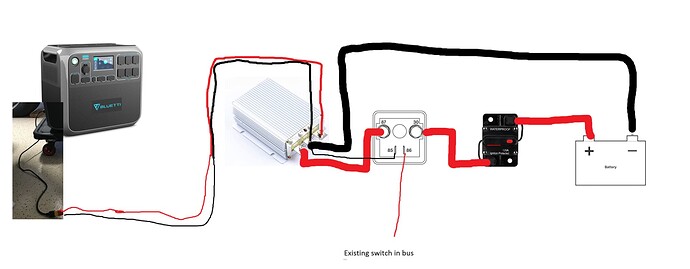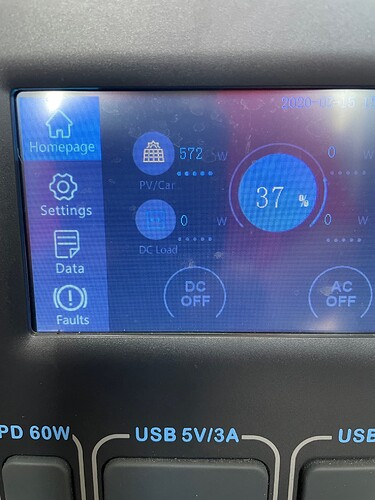Thanks. My “less-than-expert” status understands the concept but is unfamiliar with the phrase control line. Can you dive in a bit more on what that entails? Is it a thing or is it a way of wiring that is called a control line?
1- The converter would always be on unless you installed a switch. This could be done with a large capacity relay or battery solonoid switch
2- the unit appears water proof but I would install inside if feasible
Please do not overlook the important concepts in the last paragraph of Scott Benson’s original post: wire size (gauge) and over-current protection (fuse or circuit breaker) for the circuit feeding the converter.
The appropriate wire size depends on the amperage of the load, and the length of the wire run.
The maximum size of the fuse depends on the wire size; it is not related to the amperage of the load. That’s because the purpose of any fuse is to prevent a fire in the wiring. 12V systems can and do have failures that result in fires—not something you want in your expensive vehicle parked in your garage.
I would argue that the wiring from the converter to the Bluetti also needs over-current protection (appropriate for the size of the smallest wiring in that circuit). But I’m no expert.
Thanks S-B. The concept is understandable but again, due to my own ignorance, I can’t piece together the actual execution of this. Most solenoid diagrams I am seeing are for house battery setups and I cannot translate these with my pea-sized brain. Any chance you could explain or illustrate in a little more detail how you might wire in a solenoid for this type of setup?
Yeah. I left out that detail in my description but I do intend to follow all the recommendations. Those include the high amperage switch, 75 amp fuse/circuit-breaker, and the appropriate heavy gauge cables. I will be posting the parts and plan on here in advance for “approval”. ![]()
Something like a battery isolator solenoid switch or relay switch like these will carry the high current. The units functions as an electrically operated switch. One large lug connects to your battery, the other large lug would connect to your step up converter input power cable. The two small connectors on top…one would go to a 12 volt source and the other would go to the remote switch shown that would install inside the vehicle or a convenient place. This would be a manual operation. You could eliminate the manual switch and connect the small input connection to a 12 volt source that was on only when the key was in the run position. I personally prefer the manual switch method because you can then turn on or off the step up converter at will whereas if you wire it to a hot lead that is on any time the key is turned on you are also always running the step up converter any time the key is on.
I kind of like this one for the simplicity and price.:
https://www.amazon.com/Continuous-Switch-Starter-Charger-Contactor/dp/B08CXSGLKB/ref=sr_1_27?crid=2OJFE26Y65CGW&keywords=high+continueaous+current+solenoid+switch&qid=1645028853&sprefix=high+continueaous+current+solenoid+switch%2Caps%2C120&sr=8-27
Excellent. Let me try and process this into a visual layout that makes sense to me. Thanks again
Hello Scott-Benson,
Since bryhart’s design is nearing the point where circuit breaker and wire sizes must be chosen, perhaps it would be useful to summarize the amperage calculations you have previously mentioned. Here’s my crack at a summary:
-
The solar input (MPPT) of the AC200P is (I believe) a “current-limited” device. According to its specs, it will try to pull 12.0 amps from whatever is feeding it.
-
The DC/DC converter discussed in this thread is a “constant voltage” device. It will try to maintain its rated output voltage (48V in this case), regardless of how much current the load draws. You chose this converter because its maximum output current rating (15A) is larger than the max current the AC200P will draw.
-
Thus, the nominal current flowing in the wiring between the converter and MPPT will be 12 amps. If that wiring develops a short circuit, the maximum current that can flow is not really known. The converter’s specs do mention some sort of protection from a short circuit in the output circuit, but do not state how much current a short circuit could produce. People familiar with the internal design of converters may be able to estimate that maximum current, but from the specs we just don’t know. That is why a fuse in that wiring (near the converter) may be appropriate.
-
As you’ve explained, the converter will draw from the vehicle whatever current is required to achieve the input power it needs. That input power consists of the power it is sending to the Bluetti (48V x 12A ~= 580W) plus the waste heat produced by the converter.
For your installation, you were able to actually measure this input power, by measuring the input current (55A) and measuring the voltage across the input terminals of the converter (12.71V). Multiplying 55A X 12.71V we see that your converter draws ~700 Watts.
- bryhart should expect the same converter (feeding an AC200P) to also pull 700W from the school bus. If bryhart’s install can maintain the same 12.7V at the input of the converter that you achieved, then bryhart should expect 55A (=700W/12.7V) in the battery-to-converter wiring.
However, if bryhart undersizes the battery-to-converter wiring then the voltage at the input of the converter will drop and the current in that wiring will increase beyond 55A. If bryhart’s install is operated when the bus engine is shut down then voltage at the converter will also drop, and current will rise.
- To choose a wire size for the battery-to-converter wiring, bryhart should consult one of the many guides on the web, e.g. the one by BlueSea. For example, a 4 gauge circuit less than 20 feet long (10 feet from battery to converter) carrying less than 60 amps will produce a “good” (<3%) voltage drop. A smaller wire (e.g 6 gauge) would produce a larger voltage drop, which would increase the current in the wire.
Once a wire gauge is selected, the appropriate maximum circuit breaker size can be chosen.
That should work and you must need to follow the advice on proper wire size and should be good to go
So the battery-to-converter circuit should be about 10-14 feet when done (basically 5-7 feet between battery and converter). Using the chart provided that puts me in between 6 gauge and 4 gauge. Is there any disadvantage to just going with the 4 gauge to be safe?
Nope, 4 ga. would be a great idea except for cost and a little extra weight. You can always use a larger ga. but not a smaller than required.
Hello bryhart.
Before purchasing the components for your project, be sure you have a clear plan for how the two wire connections to the school bus battery will be made. That part of the project can be a hassle, depending on how the vehicle’s battery terminals are designed.
The standard method is to crimp “ring terminals” onto your two wires, and then install those rings onto existing bolts on the battery or on the battery post clamps. That sounds easy, but when you’re working with large-diameter wiring there can be some hassles. For example, crimping terminals onto 4 gauge wire is difficult without the correct tool. And the “ring” part of the ring terminal should be sized to match the bolt it will slide over. (When the ring terminal diameter is much larger than the bolt passing through it, the electrical connection can overheat due to high resistance.)
Thanks…I just saw this. I bought some things:
and some appropriately sized cable and Lug Connectors. Hopefully I will be getting all this stuff assembled and installed this weekend. I’ll take some pictures and post.
The tool you described for the terminals is what we EE call an anvil, not a crimpimg plier. I bought one through Amazon.com when I built my own EVSE in 2014 to attach 4 gage wire for its 16 kW rating, about 80 A at 240 VAC. I recommend asking help to hold it down with heavy gloves in case you miss it with the hammer (ouch!).
LOL…Too late. I couldn’t wait and did some test runs for fun. I didn’t hit my hand but first attempt had the pets ducking for cover as the tool shot across the bench. After a couple more tests I think I have a “technique”.
You can try fixing the tool to a work bench so it will not “travel” when you hammer it. Remember that the best terminal attachment result is if you can hammer it in a single blow.
Anyone know if Bluetti has any plans to develop (or is currently developing) a solution for the Alternator Charging similar to the GoalZero Yeti Link? Something nice and clean from Bluetti with the correct connectors on it , that also had a built in relay to disconnect the Start batts from the Bluetti automatically would be great
Haven’t seen or heard of anything like what you are referring to, but @BLUETTI is always looking for suggestions and is continuously making improvements so I wouldn’t be surprised to see something like that in the future.
OK. She lives!!! I have the setup wired and it seems to be working:
At idle it seems like it is maintaining 572W on the display and has charged about 5% in 15 minutes.
***EDIT - 12% in 30 minutes before I shut it down to wait for feedback from you guys.
What else do I need to check? Am I overlooking something or can I start to button this up and start using?

